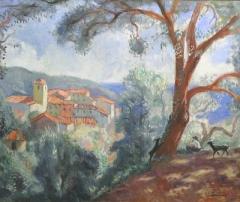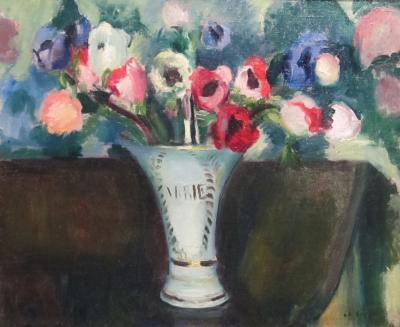- FINE ART
-
FURNITURE + LIGHTING
Shop By Category
Shop By Artist
- NEW + CUSTOM
- DECORATIVE ARTS
-
JEWELRY
Shop By Category
Shop By Artist
- INTERIORS
- MAGAZINE
Listing
Period
- Clear All
Charles Camoin
French, 1879 - 1965
A lifelong friend of Henri Matisse and Albert Marquet, each of whom Charles Camoin met while enrolled in the Beaux-Arts de Paris, the three artists were primary among those referred to as “Wild Beasts”, or “Fauvists”. Camoin himself was instrumental in the 1905 exhibit where art critic Louis Vauxcelles backhandedly anointed the artists with the title. Their Fauvist style committed colors to the primary importance, blending light and shadow equally, with their use of thick, direct brush strokes and outlined edges making for stark, strong two-dimensional paintings.
Camoin decided early on, in part through corresponding with his informal mentor, Paul Cezannes, that he would not push exaggerated boundaries, but keep to painting “truth in color”. After a childhood spend with his mother in Paris and the resorts of the Riveria, and a bleaker period of military service, in 1920 Camoin lived between Paris and Saint Tropez, immortalizing the latter as the port and city of amazing light and colors.
“I still consider myself a Fauve. There are two kinds of colors, real ones and superficial ones. You have to chose.” Camoin proved himself to be a wizened sort, and stayed away from the educational art revolutionaries of Dadaism and Cubism, and toned his heavy colors and outlined shapes and figures with realistic presence, to the delight of all.
Camoin decided early on, in part through corresponding with his informal mentor, Paul Cezannes, that he would not push exaggerated boundaries, but keep to painting “truth in color”. After a childhood spend with his mother in Paris and the resorts of the Riveria, and a bleaker period of military service, in 1920 Camoin lived between Paris and Saint Tropez, immortalizing the latter as the port and city of amazing light and colors.
“I still consider myself a Fauve. There are two kinds of colors, real ones and superficial ones. You have to chose.” Camoin proved himself to be a wizened sort, and stayed away from the educational art revolutionaries of Dadaism and Cubism, and toned his heavy colors and outlined shapes and figures with realistic presence, to the delight of all.
